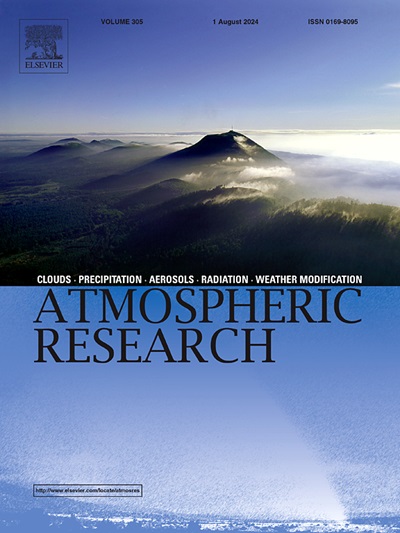雷雨云中闪电种子形成的数值模拟
IF 4.5
2区 地球科学
Q1 METEOROLOGY & ATMOSPHERIC SCIENCES
引用次数: 0
摘要
目前还不清楚闪电通道是如何在雷云内部形成的,雷云的最大电场强度大约比空气的介电强度低一个数量级。最近,一种假说被提出,根据该假说,闪电先导在等离子体通道的分层网络中形成,该网络填充了云内电场增加的区域。该研究提出了一个数值模型,用于模拟从单独的拖缆系统到复杂等离子体结构的转变,这些结构的特征是电参数的广泛分布。那些沿着云内电场矢量充分延伸的星团可以被认为是闪电种子。结果表明,它们的形成是一个相当集体的过程,可以发生在电场低于正流的传播阈值。根据所考虑的条件,流光系统出现所需的时空频率显示小于或等于雷雨云中水成物碰撞(或接近碰撞)的频率。选取6 km和9 km这两个闪电发生最典型的高度,分析了空气密度因素对闪电种子形成过程特征的影响。本文章由计算机程序翻译,如有差异,请以英文原文为准。

Numerical simulation of a lightning seed formation in a thundercloud
It is presently unclear how lightning channel forms inside a thundercloud, where maximal electric field strengths are about an order of magnitude lower than the dielectric strength of air. Recently, a hypothesis has been formulated, according to which a lightning leader forms inside a hierarchical network of plasma channels that fills an area of increased intracloud electric field. The study proposes a numerical model that is used to simulate the transition from separate streamer systems to complex plasma structures which segments are characterized by a wide spread of electrical parameters. Those clusters, which are sufficiently extended along an intracloud electric field vector, can be considered as lightning seeds. It is shown that their formation is a fairly collective process that can occur in electric fields lower than positive streamers propagation threshold. Depending on considered conditions, the required spatiotemporal frequencies of streamer systems appearance are shown to be less than or of the order of those of hydrometeors collisions (or nearly collisions) in a thundercloud. The altitudes of 6 and 9 km, which are the most typical for lightning genesis, are considered to analyze how the factor of air density influences the features of a lightning seed formation process.
求助全文
通过发布文献求助,成功后即可免费获取论文全文。
去求助
来源期刊

Atmospheric Research
地学-气象与大气科学
CiteScore
9.40
自引率
10.90%
发文量
460
审稿时长
47 days
期刊介绍:
The journal publishes scientific papers (research papers, review articles, letters and notes) dealing with the part of the atmosphere where meteorological events occur. Attention is given to all processes extending from the earth surface to the tropopause, but special emphasis continues to be devoted to the physics of clouds, mesoscale meteorology and air pollution, i.e. atmospheric aerosols; microphysical processes; cloud dynamics and thermodynamics; numerical simulation, climatology, climate change and weather modification.
 求助内容:
求助内容: 应助结果提醒方式:
应助结果提醒方式:


